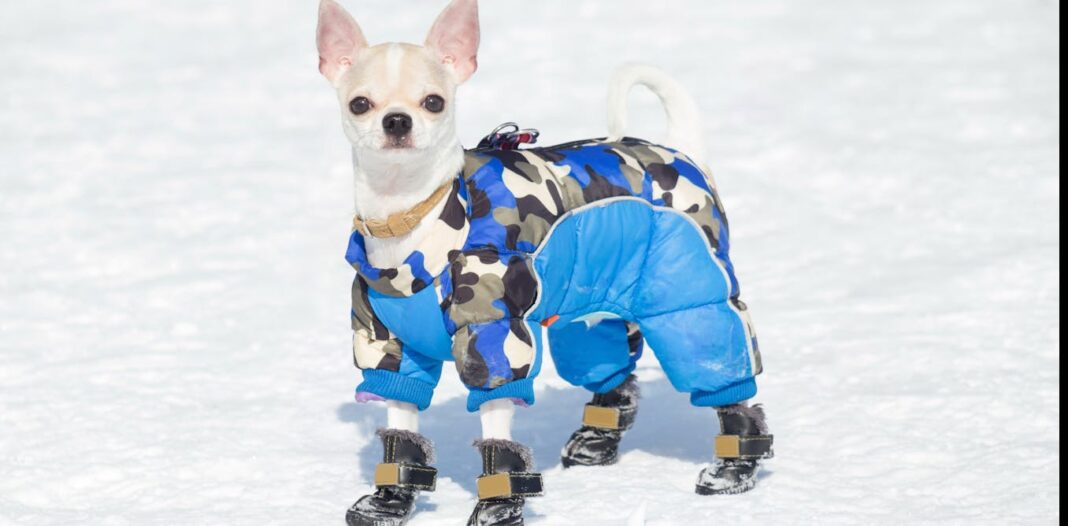Do Dogs Need a Winter Wardrobe?
1. Different Breeds, Different Needs
Yes, dogs do have their own fur coats so it’s easy to assume that additional protection is not needed for warmth. However, there is huge variation in coat type, thickness, and length across different dog breeds. Dog breeds that originated in cooler environments, such as the Siberian husky and Alaskan malamute, typically have dense double coats, meaning they cope well in cold climates and that clothing is unnecessary. But breeds such as the xoloitzcuintle are effectively hairless, and others, such as the Italian greyhound, are very fine coated with thin skin.
PAUL ATKINSON/shutterstock
As a result, these dogs may suffer if they get cold and wet so suitable waterproof coats or jumpers are a good way to keep them dry and cosy when outdoors. Even when safe indoors, though, these breeds often benefit from the additional warmth provided by suitable canine clothing.
2. Puppies and Seniors
Like all mammals, dogs have effective mechanisms to keep their body temperature constant. The thermoneutral zone (TNZ) is the range of temperatures where dogs can maintain their body temperature without using energy to warm up by shivering or cool down by panting. The TNZ for dogs ranges from 20°C to 30°C. At the lower or higher end of the TNZ, hypothermia (a dangerous drop in body temperature) or hyperthermia (overheating) can occur. Dogs who are physically mature, otherwise healthy and with thick coats can withstand a much lower critical temperature and might not need clothing. However, puppies, ill or underweight dogs and older dogs have a reduced ability to manage their body temperature. This means we might need to take extra measures to help them stay warm and comfortable – and clothing could play a key role.
3. Used to Home Comforts
Like humans, dogs become acclimatised to external temperatures. Dogs who live outside or are regularly exposed to extremes of weather are better able to cope with temperature fluctuations. If your dog is more used to the comforts of central heating and cosy, comfortable bedding, they might be less happy when it is cold and wet outside – these dogs might show signs of temperature distress by shivering or other behavioural signs, such as a hunched posture or reluctance to walk.
4. Freezing Ground
Dogs’ paws are adaptable to many different terrains. Their paw pads are thick and leathery, offering protection from external surfaces. Their claws also provide added grip and traction, including in snow and icy conditions. Do they really need booties to protect their feet from the cold, then?
Most dogs appear to be quite happy to walk on cold, frozen ground. Dogs have a counter-current heat exchange system in their lower limbs. Blood moving down to the paw pad transfers heat to blood moving in blood vessels up from the paw pad. This means that your dog’s paws can withstand lower temperatures than other parts of their body, and explains why their feet don’t freeze.
However, dogs can suffer from frostbite, especially those not used to temperature extremes or who have sensitive paws. Dogs with injured paws might be more susceptible to possible cold damage. Continuous exposure to harsh, abrasive snow, ice – and the salt and sand used to melt ice – can also cause paw damage and injury. In these cases, the use of well-fitting, specialist dog boots as worn by dogs working in hazardous conditions, such as search and rescue dogs, can protect paws.
5. Clothing Might be Convenient
Busy lifestyles can often mean we are clock watching. If you are balancing exercising your dog in the cold and wet with everyday life, the use of waterproof coats or other protective clothing can be useful and time saving. It can reduce the time needed to dry and clean your dog after being outdoors, while preventing your dog from being cold, wet and dirty when home. Clothing can help dry your dog and keep them warm after bathing or swimming – that’s better for their joints and muscles, especially for our older canine friends.
If you do decide to use clothing for your dog, it is important to first get them used to wearing it through gradual training by positive association with treats at home. Many dogs will initially dislike unusual sensations on their body or paws. They might freeze, get distressed, or move with difficulty, so avoid putting the clothing on and expecting full familiarity with it on your first outing. Do also be aware that dogs can overheat if wearing clothing or booties when they are sufficiently warm, so monitor them carefully. But, once your dog is relaxed and happy with wearing appropriate clothing, you might just find that it is a useful addition to support their health, welfare and happiness during the colder winter months.
Conclusion
While dogs may not need clothing in the same way humans do, there are certain situations where it can be beneficial for their health and wellbeing. From protecting their paws to keeping them warm and dry, there are a variety of reasons why your dog might need a winter wardrobe.
FAQs
* Do all dogs need clothing?
+ No, not all dogs need clothing. Some breeds are well adapted to cold climates and can withstand harsh weather conditions without additional protection.
* Can dogs get too hot in clothing?
+ Yes, dogs can overheat if wearing clothing or booties when they are already warm. Monitor your dog carefully to ensure they are not getting too hot.
* How do I get my dog used to wearing clothing?
+ Gradually introduce your dog to wearing clothing by positive association with treats at home. Avoid sudden or forced exposure to clothing to prevent stress.
* Can dogs suffer from frostbite?
+ Yes, dogs can suffer from frostbite, especially those with sensitive paws or those not used to cold weather. Take precautions to protect their paws and monitor them for signs of cold damage.





